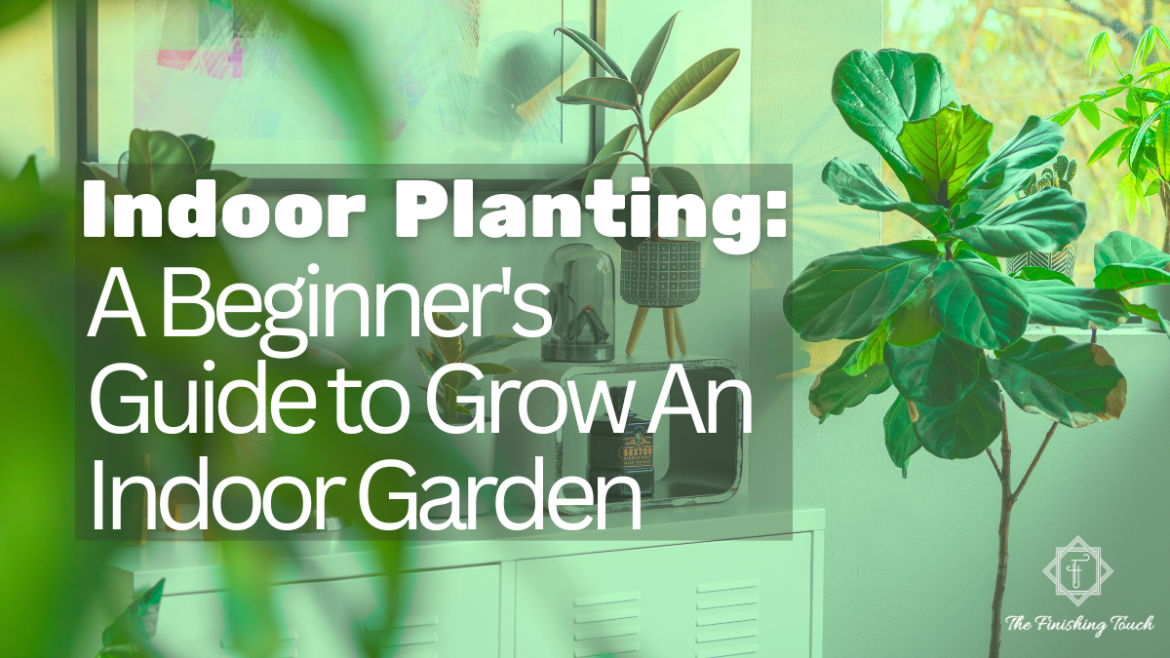Indoor Planting: A Beginner’s Guide to Grow An Indoor Garden

Indoor planting isn’t just a thing rather it is a mode of living. In the long run, the use of indoor plantings has been argued that they provide good air quality as well as add value to your house. An indoor garden can be enjoyable even if one is inexperienced in gardening. Together we will look at the necessary things to know about indoor plants and choose some household ones for growing indoors.
Why Choose Indoor Planting?
There are various reasons why people go for indoor planting even though it has various advantages for those who are living in town and also lovers of nature. Why are these the reasons why you may want such an option?
- Improves Air Quality
Houseplants breathe life into rooms by removing pollutants from the air and producing oxygen. Thus make sure your home is healthy and fresh by keeping these plants that fight air contaminants like spider plants, snake plants, and peace lilies.
- Enhances Aesthetic Appeal
Any apartment can experience a total shift once you have an inside garden since everything becomes green and fresh. It gives rise to creative ideas on how a house should look whether modern or traditional gardens with different styles.
- Mental Health Benefits
Caring for indoor houseplants has been shown to reduce stress, increase focus and improve overall mental health. For example, watering, pruning, and taking care of your plants is a good form of therapy.
- Grows in Small Spaces
If you are unlucky enough to live in an apartment or have a small garden in a house, indoor planting is one of the best ways through which you can grow anything you want. By using different containers, shelves, or hanging planters, even the smallest of spaces can become a green haven.
Starting an Indoor Plant Garden
An indoor garden may seem too difficult to start but with these tips, it can be easy and fulfilling. Here’s a simple breakdown:
- Pick The Right Spot
The first step in indoor planting is selecting the right location for your plants. Different houseplants require different light exposure, hence it is essential to select an area that meets their needs.
- Bright Indirect Light: Most houseplants do well under bright indirect light conditions which come from northern-facing windows or about two feet away from eastern or western ones.
- Low Light: A few plants like snake and ZZ can survive under very low light intensities making them ideal candidates for places with limited sunlight access like your home.
- Direct Sunlight: If you have sunlight, you can consider growing succulents or cacti because they love direct sunlight.
- Choosing Indoor Houseplants
The success of an indoor garden depends heavily on the right plants. It is wise to begin with easy-to-care-for indoor houseplants when starting as a beginner. The following are some common examples:
- Spider Plant: This type of houseplant is known for its air-purifying properties; it is also easy to grow and maintain.
- Snake Plant: Better known as “mother-in-law’s tongue,” this tough plant can endure low-light conditions and require little watering.
- Pothos: Pothos is one of those adaptable types of plants that do very well under different light situations with dangling vines including heart-shaped leaves.
- Peace Lily: This beautiful flower grows white petals which help purify air in addition to surviving on little or no light at all.
- Succulents: If you want plants that are easy to care for, then go with succulents. They need little moisture and come in many colors and forms.
- Put Together the Required Tools and Materials
Before getting into planting, ensure you have the needed tools and materials:
- Pots and Containers: Take preferably pots that have drainage holes to prevent water from logging. While plastic pots are better at holding moisture; clay ones are breathable.
- Potting Mix: For indoor plants choose a good draining potting mix. Perlite or sand can be added to improve drainage.
- Watering Can: A small watering can with a narrow spout always allows for precise watering hence it minimizes the chances of over-watering your plants.
- Fertilizer: Indoor houseplants need regular feeding. Select balanced, water-soluble fertilizers that meet the needs of indoor pot plants by following label instructions.
- Plant Stand/Shelves: Consider using plant stands/shelves as they provide more space/ storage for plants and help to make better displays.
- Planting Your Indoor Garden
Get your tools together followed by an appropriate plant selection which serves as a starting point
- Fill the Pots: Pour the potting mix into your pots, leaving about an inch to the edge of the pot.
- Plant the Houseplants: Carefully take out the plant from its nursery pot loosening up any roots it may have and placing it inside new pots. After that, pour in more potting mix then lightly compress it to eliminate all air holes.
- Water the Plants: After planting, make sure to water the plants thoroughly until water drains out from the bottom. But beware of overwatering, and do note that most indoor house plants would instead feel better when slightly dry between two successions of watering.
- Taking Care of Your Indoor Garden
As far as your indoor garden goes, it calls for consistent care and attention. Here are some vital care tips:
- Watering: For water, you must always monitor the level of moisture in the soil. Most indoor houseplants prefer slightly moist soil but should never be waterlogged.
- Fertilizing: Feed your plants every 4-6 weeks during the growing season (spring and summer) with a balanced fertilizer.
- Pruning: To keep your plants healthy and encourage new growth, you must regularly trim dead or yellowing leaves.
- Repotting: Your plants might outgrow their pots as they grow older. It would help if you re-potted them into larger containers every 1-2 years so that there would be more space available for root growth.
- Pest control: You should keep an eye out for common indoor plant pests, including aphids, spider mites, and mealybugs. If you recognize infestations of this sort on any of the affected plants, they can be treated with insecticidal soap or neem oil.
Advanced Strategies for Indoor Planting
Once you have grasped the basics of indoor planting, you may want to try out some sophisticated techniques that can improve your indoor garden:
- Grouping Plants for Microclimates
You can create microclimates by putting different plants into groups which will help maintain humidity and temperature. For instance, if you keep ferns and peace lilies together in one spot then this will lead them to favourable conditions.
- Include Indoor Houseplants into Your Home Style
Using indoor houseplants is an option to have a cohesive and visually appealing space in your house. Using hanging planters, wall-mounted planters, or ornamental containers for displaying your plants may be a good idea,
- Play with Propagation
One can increase the size of his or her home garden by propagating indoor houseplants without having to buy new ones, and this will make one happy leaving aside the issue of cost. Some common methods include:
- Cuttings: Most people like pothos and philodendrons can easily be multiplied by simply cutting their stems followed by rooting them either in water or on soil.
- Division: For example, put spider plants or peace lilies into 2 separate pots after digging them up from one pot as they grow best as two distinct plants.
- Offsets: Succulents tend to form offsets or “pups,” which are little plants that grow off part of the parent plant when separated carefully from it.
- Create a Vertical Garden
In case space is limited, think about using wall-mounted planters, shelves or trellises to create a vertical garden. This technique helps to make the most of your space and also serves as an attractive feature in your home.
- Use Grow Lights
For those who do not have enough natural lighting in their homes, grow lights can give all the necessary light waves for indoor houseplants. LED grow lights are energy-saving and can be adjusted according to the needs of different types of plants.
Everyday Problems Associated With Indoor Planting
Like with any kind of gardening indoor planting has its problems. Some of the most common problems you may encounter include:
- Overwatering or Underwatering
Indoor planting is often made difficult by overwatering. You can avoid this by allowing the soil to slightly dry between watering and always using pots that have holes for drainage. Overwatered plants may also suffer from other problems like lack of available moisture because they need it regularly.
- Insufficient Light
Leggy growth and fade in vibrant colors may result from a lack of light. If you notice your flowers stretching towards the light source, bringing them closer to a window or using grow lights should be considered.
- Infestations of Pests
Inside the home, common pests may include aphids, spider mites, and fungus gnats that assault potted indoor plants. It is advisable to check your indoor plants regularly for pest signs and control pests using either natural or chemical interventions as soon as they are detected so that they do not worsen.
- Nutritional Deficiencies
When your plants exhibit nutritional deficiency symptoms like yellowing leaves or stunted growth, consider giving them some nutrient-rich fertilizer. Make sure you stick to the recommended feeding timetable so as to avoid over-fertilization.
Conclusion: A Green Fostering Home With Indoor Plantings
Habitat enhancement with a pocket garden is both a satisfying and fulfilling hobby bringing nature’s beauty to one’s house. And though beginners often shy away based on lack of experience or resources, this guide offers ample information on how anyone can start an indoor garden filled with healthy indoor houseplants. The guide also covers everything from selecting the right plants and sites to high-level process mastery.
If you want to improve the air quality in your house, increase its beauty, or just enjoy seeing greenery inside, you should indulge in indoor planting activities. Hence set out your pots, choose the best indoor houseplants that please you, and let them grow into a home environment!
For more gardening tips, browse through our other pieces about home gardens and landscape designs. Happy planting!

